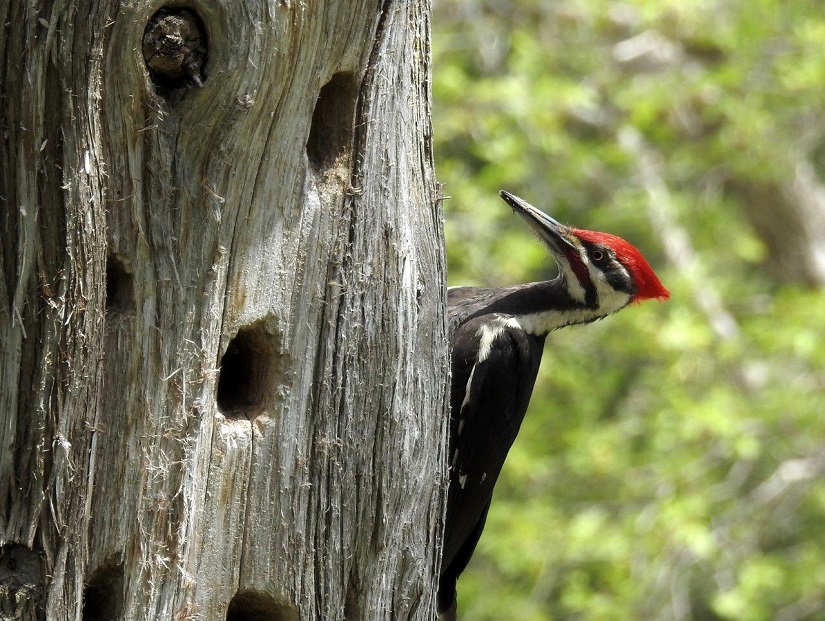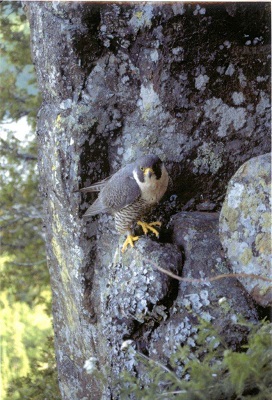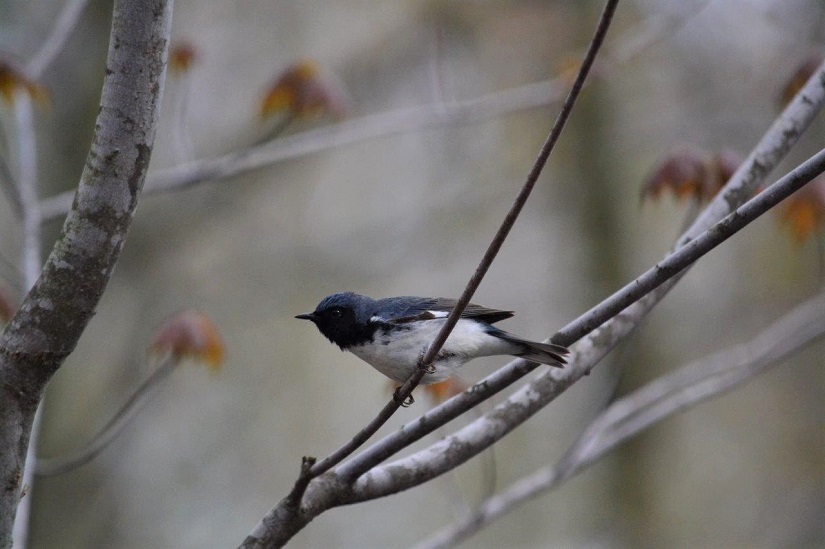Today’s post comes from Kaitlyn Plastino, Discovery staff at Lake Superior Provincial Park.
One of the best things about Lake Superior Provincial Park is its abundance in excellent wildlife-watching opportunities.
Whether you’re staying for a week, or just visiting for the day, our diverse range of habitats makes our park a birdwatcher’s paradise year-round.
No matter the season, you’re bound to spot some of the species from this checklist!
Winter birding (December, January, February)
While most birds have migrated south for the winter, there are still plenty of bright colours that stay at Lake Superior. Winter offers a great opportunity to see them without the hustle and bustle of breeding birds!
Woodpeckers are common in our woodlands, especially the Downey, Hairy, and Pileated woodpeckers.

These species can be found drilling away at trees to find ants, insect larvae, wood-boring beetles, and even grains and berries!
While it may be difficult for new birders to tell these species apart, the best hint towards which woodpecker you’re seeing is by their size. Think about it alphabetically: Downeys are smaller than Hairies, and Hairies are smaller than Pileated.

Nuthatches can be found searching for cached seeds and insects in bark crevices, or feeding directly from conifer cones and seedpods.
They have quite a unique silhouette, as they often hop down tree trunks head-first!
While you’re walking through our mixed forests, keep an ear out for the nasal “yank-yank-yank” call of the Red-breasted Nuthatch, and the fast-paced “wha-wha-wha” call of the White-breasted Nuthatch.
The Red-breasted Nuthatch is especially common along our Nokomis Trail.
Pine Grosbeaks are bright songbirds bringing a dash of colour to our leafless trees in the winter.

You might find them foraging at conifers looking for seeds, or flitting through the branches of other shrubs breaking apart seeds, needles, and buds to satiate their hunger.
The males and females look very different; males boast a bright red body and grey breast, while females display a more understated yellow upper part and smoky grey chest.
Spring birding (March, April, May)
While most species arrive in summer, there are still many birds that find their way to our park in advance to scout out prime breeding territories. As they say, “the early bird gets the worm!”
If you hear any loud crashing sounds in the leaf-litter, don’t panic; it might just be a White-throated Sparrow!

For such a small bird, they make an awful lot of noise by scratching up leaves on the forest floor, and pouncing on any insects they uncover.
This species comes with two different colours of stripes on their heads: white or tan. Their song has 2-3 pitches, ascending or descending to the words “Oh-Sweet-Canada-Canada-Canada.”
A popular spot to hear and see White-throated Sparrows is Trapper’s Trail.
Dark-eyed Juncos are easily recognizable with their slate-coloured head, light underside, and bright white tail feathers.

Dark-eyed Juncos can be seen foraging on the ground, feasting on the small seeds of grasses and weeds. They also feed in the underbrush on moths, flies, and beetles as insects become more available in the warming season.
They are a frequent flyer at our campgrounds, and their high, short ‘chip’ can be heard as they look for food.
American Goldfinches are easy to spot when they arrive at their breeding grounds in May – they’re bright yellow!

Their cone-shaped bill is designed specifically for extracting seeds from their favourite plants: asters, alders, and birch.
If you listen carefully, you can hear them say “po-ta-to-chip!” as they fly through the air.
Summer birding (June, July, August)
As summer rolls around, so do the warblers. Lake Superior offers a diverse and largely protected habitat for hundreds of bird species, making our park a great breeding ground.
Wherever you are in the park, you are bound to see your fill of feathered friends in the summer.
Common Loons are a common sight in the park, and remind us of peaceful summer outdoor adventures.

Their haunting and recognizable call can be heard on many lakes, including Lake Superior. They are also a permanent resident of Mijinemungshing Lake, the largest inland lake in the park.
They are frequently seen in pairs fishing for frogs, leeches, crayfish, and other aquatic species. Keep your eyes peeled for these well-camouflaged swimmers.

The Peregrine Falcon is the fastest animal in the world, clocking in at a maximum of 390 km/hr while they dive through the air.
Despite being extirpated from Ontario in the 1960s due to the harmful effects of DDT pesticides, these magnificent birds of prey have made a great comeback with the help of recovery programs at the park.
They’re most likely to be seen circling the shoreline of Lake Superior near cliff faces, an easy place to hunt for gulls, ducks, or shorebirds.
You don’t want to miss out on these birds in action, so make sure you’re looking to the skies when you’re out on the Coastal Trail!
Black-throated Blue Warbler has a blue back and head that contrasts heavily with its black face and white chest.

In the summer, you can see them carefully picking insects off the underside of tree leaves in the lower canopy, or shrubs.
They sing a quirky “please, please, please squeeeeze” during the breeding season, and are a popular sight at Gargantua.
Fall birding (September, October, November)
Although the breeding season has died down and many of the more colourful birds have started their journey back south for the winter, Lake Superior is still a great place for fall birding if you know what to look for.
Black-capped Chickadees are both acrobatic and curious, so you should be able to spot these little puffballs throughout our campgrounds all year.

They’re quite the iconic figure with their bright white cheeks contrasting against their black hood and bib.
They begin to forage in flocks during autumn, each individual caching away as many as 80,000 seeds for winter.
Their melodic song “hey-sweetie” or their name-sake call “chickadee-dee-dee” can be heard as they zip from branch to branch.
While they look similar to female cardinals with their brown head crest, Cedar Waxwings can be easily identified by their black mask, red wing patch, and yellow tipped tail feathers.

In the fall, you are likely to see flocks of these birds forage for berries together. They’re particularly fond of eating mountain ash berries!
Ruffed Grouse are a cryptically coloured game bird widely abundant at Lake Superior in the fall.

They spend most of their time on the ground, picking at berries, acorns, and other vegetation.
They may be difficult to spot, but don’t be too surprised if the autumn leaves erupt with a startled grouse when you’re out hiking.
Ready, set, bird!
Now that you’re familiar with the common birds at Lake Superior during all seasons, you’re ready to set out on a birding adventure!
Make sure you bring a notebook to write down all your great finds, and upload them to iNaturalist.
If you have any questions about which bird you saw, stop by the information desk at the Visitor’s Centre between late May to mid-October, and we’ll help you out.
Now grab your binoculars and get out there!
